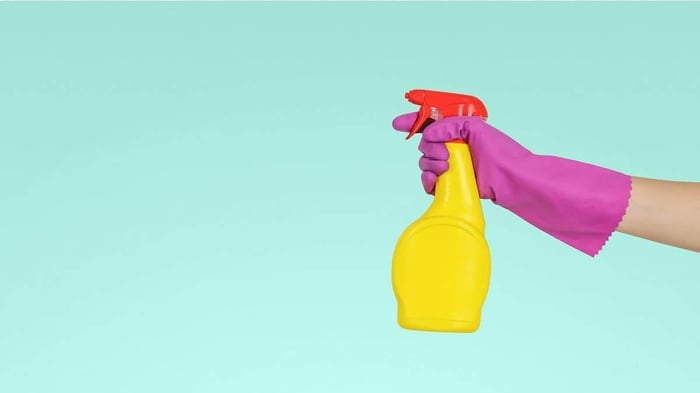Microfiber Guide and Laundering Instructions
The following microfiber cleaning products user guide is free to print and utilize by healthcare and hospitality housekeeping and janitorial staff. Below we will discuss the microfiber guide and how to best care for microfiber.







Benefits of Microfiber
Microfiber is a synthetic fiber known for its versatility and performance in different applications, from cleaning products to clothing and furniture upholstery. Here’s a comprehensive look at the benefits of microfiber Direct Textile Store has to offer and why it has become such a popular material in many industries.
Exceptional Cleaning Power and High Absorbency
Microfiber can absorb up to seven times its weight in water, making it highly effective for cleaning spills and drying surfaces.
Effective Dirt and Dust Removal
The fibers are incredibly fine, often measuring less than one denier in diameter, which allows microfiber cloths to pick up and trap dust, dirt, and even bacteria. This makes them ideal for cleaning surfaces without the need for chemical cleaners.
Non-Abrasive
Microfiber is soft and non-abrasive, meaning it won't scratch or damage surfaces, including delicate items like eyeglasses, computer screens, and car finishes.
Durability and Longevity
Microfiber products are known for their durability. The synthetic fibers are resilient and can withstand repeated use and washing without breaking down or losing effectiveness.
Cost-Effective
Although microfiber products may have a higher initial cost compared to traditional cleaning materials, their longevity and reusability make them a cost-effective choice in the long run.
Environmental Benefits
Because microfiber can clean effectively with just water, it reduces the need for chemical cleaning agents. This is beneficial for both the environment and personal health, as it minimizes chemical exposure.
Reusable
Microfiber products can be washed and reused many times, reducing the waste associated with disposable cleaning products like paper towels and cleaning wipes.
Health Benefits
Microfiber is hypoallergenic, which makes it a good choice for people with allergies or sensitivities. It effectively traps dust, pollen, and other allergens, helping to improve indoor air quality.
Antibacterial Properties
Some microfiber products are designed with antibacterial properties, which can help reduce the spread of bacteria and germs on surfaces.
Versatility
Microfiber is used in various products, including cleaning cloths, mops, towels, clothing, furniture upholstery, and car interiors. Its versatility makes it suitable for many different tasks and environments.
Comfort and Convenience
In clothing and linens, microfiber is soft against the skin and provides a comfortable feel. Its lightweight and breathable nature make it ideal for activewear and beddings.
Quick-Drying
Microfiber dries quickly, which is beneficial for both cleaning applications and clothing. This property reduces the risk of mold and mildew growth in damp environments.
Enhanced Aesthetic and Maintenance
Microfiber is naturally resistant to stains, which makes it an excellent choice for upholstery and carpets. It repels liquids and makes cleaning up spills easier.
Easy to Maintain
Products made from microfiber are generally easy to care for. They can usually be machine washed and dried without losing their shape or effectiveness.
Microfiber's benefits make it an great material for a wide range of applications. Its cleaning power, durability, environmental advantages, health benefits, versatility, and comfort all contribute to its popularity. Whether used in household cleaning, clothing, or upholstery, microfiber offers a practical and efficient solution that meets the demands of modern consumers and professionals alike. Its ability to perform well in various contexts, combined with its ease of maintenance and cost-effectiveness, ensures that microfiber remains a preferred choice in many industries.
Microfiber Laundering Instructions
The best way to clean and disinfect contaminated microfiber products is to launder them in a wash machine using the recommended microfiber laundering instructions formula below.
Wash/Dry Formula Guidelines - Microfiber Products
Washing Recommendation:
Flush 2 Minutes @110 Degrees – High Water Level
Flush 2 Minutes @120 Degrees – High Water Level
Flush 2 Minutes @130 Degrees – High Water Level
Break/Suds 6 Minutes @ 140 Degrees – Low to Medium Water Level
3 ounces Phosphate with 6 ounces Detergent (Per CWT)
(If no Phosphate, 9 oz Detergent Per CWT)
Rinse 2 Minutes @ 130 Degrees – High Level
Rinse 2 Minutes @ 120 Degrees – High Level
Rinse 2 Minutes @ 110 Degrees – High Level
Extract 5 Minutes – High Speed
Do not use fabric softeners during the wash process, as the oils and cationic surfactants can clog up the fibers and make them less absorbent.
Drying Recommendation:
Dry at a stack temperature that will keep the chamber below 140F. Typical dry time is 10 minutes.
For further information, contact your :Laundering Chemical Representative.
Laundering microfiber cloth and linens is easy, but it should always be done with care! To protect the material, machine washing is recommended, as opposed to hand-washing. When washing microfiber textiles, it is important to use mild detergents that are free of bleach and fabric softeners. Washing on the delicate cycle with cold water helps prevent fabric from becoming damaged. It's also important to avoid using too much detergent in the wash and make sure everything is completely rinsed out before drying. Microfiber items should be gently tumbled on low heat for best results. As an added measure of care for microfiber items, hang them up or lay them flat to dry whenever possible. With these simple steps you can keep your microfiber linens looking great for years of use!
To learn more about microfiber products and why they are so effective, check out our microfiber article.

Copy & Paste to Link to this Post!
<a href="https://directtextilestore.com/blog/microfiber-user-guide/">Microfiber User Guide</a>About the Author
Haley Bridges, Marketing Assistant at Direct Textile Store
Haley Bridges has served as Marketing Assistant at Direct Textile Store, where she specializes in hospitality linens, uniforms, and bulk textile solutions. She works closely with hotels, restaurants, and healthcare facilities to match them with durable, high-quality products that balance both performance and value. Haley's expertise in textile sourcing and merchandising strategy helps businesses make confident purchasing decisions while staying ahead of industry trends.
If you need assistance, contact Direct Textile Store Customer Service at 800-615-5822




